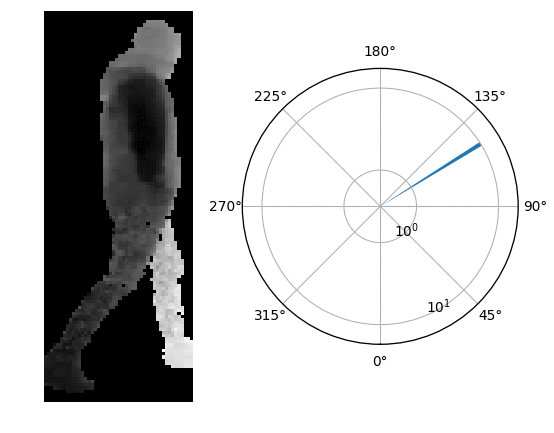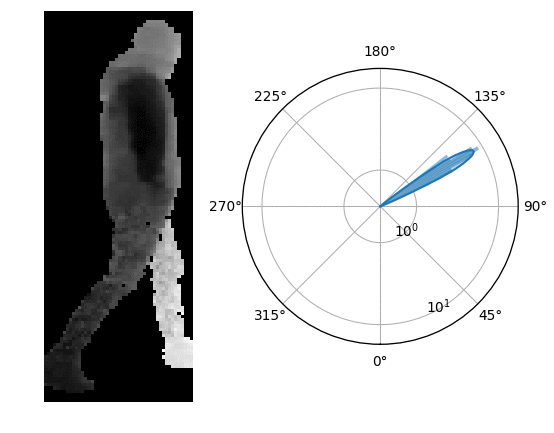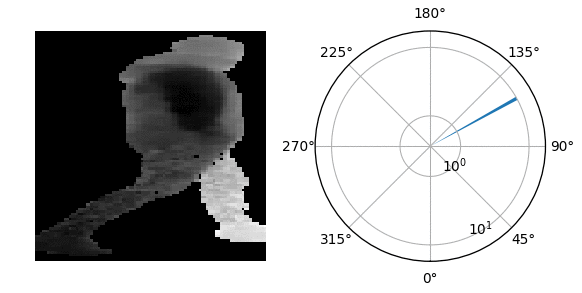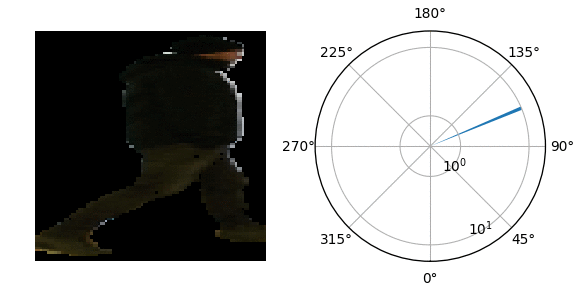Fast and Robust Upper Body Orientation Estimation for Mobile Robotic Applications using Tensorflow (Python 3.6).
-
Clone repository:
git clone https://github.com/tui-nicr/deep-orientation.git
-
Set up environment and install dependencies:
# create Python 3.6 environment conda create --name env_deep_orientation python=3.6 conda activate env_deep_orientation # install dependencies # GPU version: pip install -r /path/to/this/repository/requirements_gpu.txt [--user] # CPU version: pip install -r /path/to/this/repository/requirements_cpu.txt [--user] # opt. dependencies to plot models, see src/plot_models.py conda install graphviz pydot
-
For network training: Download NICR RGB-D Orientation Data Set and install dataset package
-
Change directory to
srccd /path/to/this/repository/src -
Apply best performing modified beyer architecture network (depth input, biternion output, mean absolute error of 5.28° on test set)
# single prediction (without dropout sampling) python inference.py \ beyer_mod_relu \ ../trained_networks/beyer_mod_relu__depth__126x48__biternion__0_030000__1/weights_valid_0268.hdf5 \ ../nicr_rgb_d_orientation_data_set_examples/small_patches \ --input_type depth \ --input_preprocessing standardize \ --input_height 126 \ --input_width 48 \ --output_type biternion \ --n_samples 1 [--cpu]# multiple predictions to estimate uncertainty (with dropout sampling) python inference.py \ beyer_mod_relu \ ../trained_networks/beyer_mod_relu__depth__126x48__biternion__0_030000__1/weights_valid_0268.hdf5 \ ../nicr_rgb_d_orientation_data_set_examples/small_patches \ --input_type depth \ --input_preprocessing standardize \ --input_height 126 \ --input_width 48 \ --output_type biternion \ --n_samples 25 [--cpu] -
Apply best performing MobileNet v2 architecture network (depth input, biternion output, mean absolute error of 5.17° on test set)
# single prediction (without dropout sampling) python inference.py \ mobilenet_v2 \ ../trained_networks/mobilenet_v2_1_00__depth__96x96__biternion__0_001000__2/weights_valid_0268.hdf5 \ ../nicr_rgb_d_orientation_data_set_examples/small_patches \ --input_type depth \ --input_preprocessing scale01 \ --input_height 96 \ --input_width 96 \ --output_type biternion \ --mobilenet_v2_alpha 1.00 \ --n_samples 1 [--cpu] -
Apply best performing RGB MobileNet v2 architecture network (rgb input, biternion output, mean absolute error of 7.98° on test set)
# single prediction (without dropout sampling) python inference.py \ mobilenet_v2 \ ../trained_networks/mobilenet_v2_1_00__rgb__96x96__biternion__0_001000__0/weights_valid_0134.hdf5 \ ../nicr_rgb_d_orientation_data_set_examples/small_patches \ --input_type rgb \ --input_preprocessing scale01 \ --input_height 96 \ --input_width 96 \ --output_type biternion \ --mobilenet_v2_alpha 1.00 \ --n_samples 1 [--cpu]
-
Change directory to
srccd /path/to/this/repository/src -
Extract patches
python extract_patches.py --dataset_basepath /path/to/nicr_rgb_d_orientation_data_set
-
Train (GPU only) multiple neural networks with same hyperparameters
# best performing configuration and hyperparameters from paper python train.py \ beyer_mod_relu \ --dataset_basepath /path/to/nicr_rgb_d_orientation_data_set \ --output_basepath /path/where/to/store/training/output/files \ --input_type depth \ --input_preprocessing standardize \ --input_height 126 \ --input_width 48 \ --output_type biternion \ --learning_rate 0.03 \ --run_id 0 python train.py \ beyer_mod_relu \ --dataset_basepath /path/to/nicr_rgb_d_orientation_data_set \ --output_basepath /path/where/to/store/training/output/files \ --input_type depth \ --input_preprocessing standardize \ --input_height 126 \ --input_width 48 \ --output_type biternion \ --learning_rate 0.03 \ --run_id 1 python train.py \ beyer_mod_relu \ --dataset_basepath /path/to/nicr_rgb_d_orientation_data_set \ --output_basepath /path/where/to/store/training/output/files \ --input_type depth \ --input_preprocessing standardize \ --input_height 126 \ --input_width 48 \ --output_type biternion \ --learning_rate 0.03 \ --run_id 2For further details and parameters, see:
python train.py --help usage: train.py [-h] [-o OUTPUT_BASEPATH] [-db DATASET_BASEPATH] [-ds {small,large}] [-ts TRAINING_SET] [-vs VALIDATION_SETS [VALIDATION_SETS ...]] [-it {depth,rgb,depth_and_rgb}] [-iw INPUT_WIDTH] [-ih INPUT_HEIGHT] [-ip {standardize,scale01,none}] [-ot {regression,classification,biternion}] [-lr LEARNING_RATE] [-lrd {poly}] [-m MOMENTUM] [-ne N_EPOCHS] [-es EARLY_STOPPING] [-b BATCH_SIZE] [-vb VALIDATION_BATCH_SIZE] [-nc N_CLASSES] [-k KAPPA] [-opt {sgd,adam,rmsprop}] [-naug] [-rid RUN_ID] [--mobilenet_v2_alpha {0.35,0.5,0.75,1.0}] [-d DEVICES] [-v] {beyer,beyer_mod,beyer_mod_relu,mobilenet_v2,beyer_mod_relu_sep} Train neural network for orientation estimation positional arguments: {beyer,beyer_mod_relu,mobilenet_v2} Model to use: beyer, beyer_mod_relu or mobilenet_v2 optional arguments: -h, --help show this help message and exit -o OUTPUT_BASEPATH, --output_basepath OUTPUT_BASEPATH Path where to store output files, default: '/results/rotator' -db DATASET_BASEPATH, --dataset_basepath DATASET_BASEPATH Path to downloaded dataset (default: '/datasets/rotator') -ds {small,large}, --dataset_size {small,large} Dataset image size to use. One of :('small', 'large'), default: small -ts TRAINING_SET, --training_set TRAINING_SET Set to use for training, default: training -vs VALIDATION_SETS [VALIDATION_SETS ...], --validation_sets VALIDATION_SETS [VALIDATION_SETS ...] Sets to use for validation, default: [validation, test] -it {depth,rgb,depth_and_rgb}, --input_type {depth,rgb,depth_and_rgb} Input type. One of ('depth', 'rgb', 'depth_and_rgb'), default: depth -iw INPUT_WIDTH, --input_width INPUT_WIDTH Patch width to use, default: 96 -ih INPUT_HEIGHT, --input_height INPUT_HEIGHT Patch height to use, default: 96 -ip {standardize,scale01,none}, --input_preprocessing {standardize,scale01,none} Preprocessing to apply. One of [standardize, scale01, none], default: standardize -ot {regression,classification,biternion}, --output_type {regression,classification,biternion} Output type. One of ('regression', 'classification', 'biternion'), default: biternion) -lr LEARNING_RATE, --learning_rate LEARNING_RATE (Base) learning rate, default: 0.01 -lrd {poly}, --learning_rate_decay {poly} Learning rate decay to use, default: poly -m MOMENTUM, --momentum MOMENTUM Momentum to use, default: 0.9 -ne N_EPOCHS, --n_epochs N_EPOCHS Number of epochs to train, default: 800 -es EARLY_STOPPING, --early_stopping EARLY_STOPPING Number of epochs with no improvement after which training will be stopped, default: 100.To disable early stopping use -1. -b BATCH_SIZE, --batch_size BATCH_SIZE Batch size to use, default: 128 -vb VALIDATION_BATCH_SIZE, --validation_batch_size VALIDATION_BATCH_SIZE Batch size to use for validation, default: 512 -nc N_CLASSES, --n_classes N_CLASSES Number of classes when output_type is classification, default: 8 -k KAPPA, --kappa KAPPA Kappa to use when output_type is biternion or regression, default: biternion: 1.0, regression: 0.5 -opt {sgd,adam,rmsprop}, --optimizer {sgd,adam,rmsprop} Optimizer to use, default: sgd -naug, --no_augmentation Disable augmentation -rid RUN_ID, --run_id RUN_ID Run ID (default: 0) -ma {0.35,0.5,0.75,1.0}, --mobilenet_v2_alpha {0.35,0.5,0.75,1.0} Alpha value for MobileNet v2 (default: 1.0) -d DEVICES, --devices DEVICES GPU device id(s) to train on. (default: 0) -v, --verbose Enable verbose output -
Evaluate trained networks
# this creates a json file containing a deeper analysis of the trained networks python eval.py \ biternion \ --dataset_basepath /path/to/nicr_rgb_d_orientation_data_set \ --set test \ --output_path /path/where/to/store/evaluation/output/files \ --training_basepath /path/where/to/store/training/output/files
For further details and parameters, see:
python eval.py --help usage: eval.py [-h] [-o OUTPUT_PATH] [-tb TRAINING_BASEPATH] [-s {validation,test}] [-ss {training,validation,test}] [-db DATASET_BASEPATH] [-ds {small,large}] [-v] {regression,classification,biternion} Evaluate trained neural networks for orientation estimation positional arguments: {regression,classification,biternion} Output type. One of ('regression', 'classification', 'biternion') (default: biternion) optional arguments: -h, --help show this help message and exit -o OUTPUT_PATH, --output_path OUTPUT_PATH Path where to store created output files, default: '../eval_outputs/' relative to the location of this script -tb TRAINING_BASEPATH, --training_basepath TRAINING_BASEPATH Path to training outputs (default: '/results/rotator') -s {validation,test}, --set {validation,test} Set to use for evaluation, default: test -ss {training,validation,test}, --selection_set {training,validation,test} Set to use for deriving the best epoch, default: validation -db DATASET_BASEPATH, --dataset_basepath DATASET_BASEPATH Path to downloaded dataset (default: '/datasets/rotator') -ds {small,large}, --dataset_size {small,large} Dataset image size to use. One of :('small', 'large'), default: small -v, --verbose Enable verbose output
The source code is published under BSD 3-Clause license, see license file for details.
If you use the source code or the network weights, please cite the following paper:
Lewandowski, B., Seichter, D., Wengefeld, T., Pfennig, L., Drumm, H., Gross, H.-M. Deep Orientation: Fast and Robust Upper Body Orientation Estimation for Mobile Robotic Applications. in: IEEE/RSJ Int. Conf. on Intelligent Robots and Systems (IROS), Macau, pp. 441-448, IEEE 2019
@InProceedings{Lewandowski-IROS-2019,
author = {Lewandowski, Benjamin and Seichter, Daniel and Wengefeld, Tim and Pfennig, Lennard and Drumm, Helge and Gross, Horst-Michael},
title = {Deep Orientation: Fast and Robust Upper Body Orientation Estimation for Mobile Robotic Applications},
booktitle = {IEEE/RSJ Int. Conf. on Intelligent Robots and Systems (IROS), Macau},
year = {2019},
pages = {441--448},
publisher = {IEEE},
}


